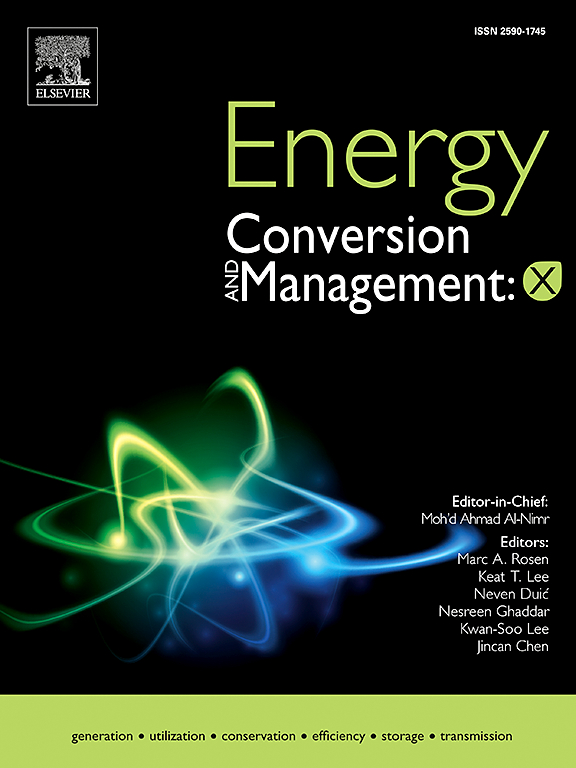改装远程氢能飞机:可持续航空的可行之路?
IF 7.1
Q1 ENERGY & FUELS
引用次数: 0
摘要
航空业面临着越来越大的脱碳压力,但由于需要高能量密度的燃料,远程飞行的替代品有限。氢气是一种很有前途的候选者,但其可行性取决于选择最佳生产途径,解决氮氧化物(NOx)排放问题,以及管理氢气泄漏。本研究全面评估了改装远程氢能飞机的六种制氢途径,评估了它们的排放、运营成本和环境成本权衡。结果表明,在没有氮氧化物减排的情况下,即使在最有利的途径(可再生电解,ERE)下,氢动力飞机的二氧化碳当量(CO2eq)也比Jet-A多8.6%至58.6%。此外,氢燃料飞机的直接运营成本明显更高,中型双通道飞机的成本增加了91%,超大型飞机的成本增加了132%。一项氮氧化物敏感性分析表明,中型双通道飞机要实现比Jet-A更低的排放,至少需要减少15%的氮氧化物,而大型飞机则需要减少60-75%。生态效率指数证实,即使减少了氮氧化物排放,氢燃料飞机的成本效益仍然低于喷气- a。此外,远程飞机的氢泄漏惩罚更高,凸显了额外的可持续性挑战。本文章由计算机程序翻译,如有差异,请以英文原文为准。
Retrofitted long-range hydrogen aircraft: A viable path to sustainable aviation?
The aviation industry faces increasing pressure to decarbonize, yet long-range flights have limited alternatives due to the need for high-energy–density fuels. Hydrogen is a promising candidate, but its feasibility depends on selecting the optimal production pathway, addressing nitrogen oxides (NOx) emissions, and managing hydrogen leakage. This study comprehensively evaluates six hydrogen production pathways for retrofitted long-range hydrogen aircraft, assessing their emissions, operating costs, and environmental-cost trade-offs. The results show that without NOx mitigation, hydrogen-powered aircraft emit 8.6% to 58.6% more equivalent of carbon dioxide (CO2eq) than Jet-A even under the most favorable pathway (renewable electrolysis, ERE). Additionally, hydrogen aircraft’s direct operating cost is significantly higher, with ERE increasing costs by 91% in medium twin-aisle aircraft and up to 132% in very large aircraft. A NOx sensitivity analysis indicates that at least 15% NOx reduction is required for medium twin-aisle aircraft to achieve lower emissions than Jet-A, while larger aircraft need reductions of 60–75%. The Eco-Efficiency Index confirms that even with NOx mitigation, hydrogen aircraft remain less cost-efficient than Jet-A. Furthermore, hydrogen leakage penalties are higher in ERE for long-range aircraft, highlighting additional sustainability challenges.
求助全文
通过发布文献求助,成功后即可免费获取论文全文。
去求助
来源期刊

Energy Conversion and Management-X
Multiple-
CiteScore
8.80
自引率
3.20%
发文量
180
审稿时长
58 days
期刊介绍:
Energy Conversion and Management: X is the open access extension of the reputable journal Energy Conversion and Management, serving as a platform for interdisciplinary research on a wide array of critical energy subjects. The journal is dedicated to publishing original contributions and in-depth technical review articles that present groundbreaking research on topics spanning energy generation, utilization, conversion, storage, transmission, conservation, management, and sustainability.
The scope of Energy Conversion and Management: X encompasses various forms of energy, including mechanical, thermal, nuclear, chemical, electromagnetic, magnetic, and electric energy. It addresses all known energy resources, highlighting both conventional sources like fossil fuels and nuclear power, as well as renewable resources such as solar, biomass, hydro, wind, geothermal, and ocean energy.
 求助内容:
求助内容: 应助结果提醒方式:
应助结果提醒方式:


